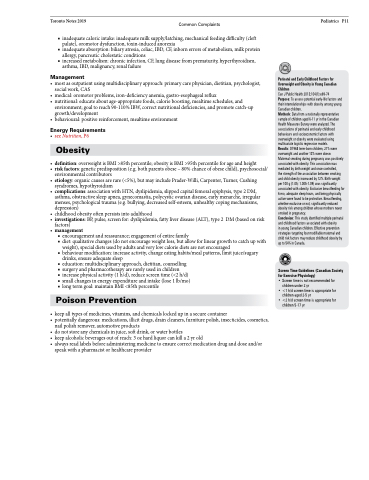Page 1045 - TNFlipTest
P. 1045
Toronto Notes 2019 Common Complaints
■ inadequate caloric intake: inadequate milk supply/latching, mechanical feeding difficulty (cleft palate), oromotor dysfunction, toxin-induced anorexia
■ inadequate absorption: biliary atresia, celiac, IBD, CF, inborn errors of metabolism, milk protein allergy, pancreatic cholestatic conditions
■ increased metabolism: chronic infection, CF, lung disease from prematurity, hyperthyroidism, asthma, IBD, malignancy, renal failure
Management
• mostasoutpatientusingmultidisciplinaryapproach:primarycarephysician,dietitian,psychologist, social work, CAS
• medical:oromotorproblems,iron-deficiencyanemia,gastro-esophagealreflux
• nutritional:educateaboutage-appropriatefoods,calorieboosting,mealtimeschedules,and
environment; goal to reach 90-110% IBW, correct nutritional deficiencies, and promote catch-up
growth/development
• behavioural: positive reinforcement, mealtime environment
Energy Requirements
• seeNutrition,P6 Obesity
• definition: overweight is BMI >85th percentile; obesity is BMI >95th percentile for age and height
• risk factors: genetic predisposition (e.g. both parents obese – 80% chance of obese child), psychosocial/
environmental contributors
• etiology:organiccausesarerare(<5%),butmayincludePrader-Willi,Carpenter,Turner,Cushing
syndromes, hypothyroidism
• complications:associationwithHTN,dyslipidemia,slippedcapitalfemoralepiphysis,type2DM,
asthma, obstructive sleep apnea, gynecomastia, polycystic ovarian disease, early menarche, irregular menses, psychological trauma (e.g. bullying, decreased self-esteem, unhealthy coping mechanisms, depression)
• childhood obesity often persists into adulthood
• investigations: BP, pulse, screen for: dyslipidemia, fatty liver disease (ALT), type 2 DM (based on risk
factors)
• management
■ encouragement and reassurance; engagement of entire family
■ diet: qualitative changes (do not encourage weight loss, but allow for linear growth to catch up with
weight), special diets used by adults and very low calorie diets are not encouraged
■ behaviour modification: increase activity, change eating habits/meal patterns, limit juice/sugary
drinks, ensure adequate sleep
■ education: multidisciplinary approach, dietitian, counselling
■ surgery and pharmacotherapy are rarely used in children
■ increase physical activity (1 h/d), reduce screen time (<2 h/d)
■ small changes in energy expenditure and intake (lose 1 lb/mo)
■ long term goal: maintain BMI <85th percentile
Poison Prevention
• keepalltypesofmedicines,vitamins,andchemicalslockedupinasecurecontainer
• potentiallydangerous:medications,illicitdrugs,draincleaners,furniturepolish,insecticides,cosmetics,
nail polish remover, automotive products
• donotstoreanychemicalsinjuice,softdrink,orwaterbottles
• keepalcoholicbeveragesoutofreach:3ozhardliquorcankilla2yrold
• alwaysreadlabelsbeforeadministeringmedicinetoensurecorrectmedicationdruganddoseand/or
speak with a pharmacist or healthcare provider
Pediatrics P11
Perinatal and Early Childhood Factors for Overweight and Obesity in Young Canadian Children
Can J Public Health 2013;104(1):e69-74 Purpose: To assess potential early-life factors and their interrelationships with obesity among young Canadian children.
Methods: Data from a nationally representative sample of children aged 6-11 yr in the Canadian Health Measures Survey were analyzed. The associations of perinatal and early childhood behaviours and socioeconomic factors with overweight or obesity were evaluated using multivariate logistic regression models.
Results: Of 968 term-born children, 21% were overweight and another 13% were obese. Maternal smoking during pregnancy was positively associated with obesity. This association was mediated by birth weight and once controlled,
the strength of the association between smoking and child obesity increased by 12%. Birth weight per 100 g (1.05; 1.005-1.09) was significantly associated with obesity. Exclusive breastfeeding for 6 mo, adequate sleep hours, and being physically active were found to be protective. Breastfeeding, whether exclusive or not, significantly reduced obesity risk among children whose mothers never smoked in pregnancy.
Conclusion: This study identified multiple perinatal and childhood factors associated with obesity
in young Canadian children. Effective prevention strategies targeting four modifiable maternal and child risk factors may reduce childhood obesity by up to 54% in Canada.
Screen Time Guidelines (Canadian Society for Exercise Physiology)
• Screen time is not recommended for
children under 2 yr
• <1 h/d screen time is appropriate for
children aged 2-5 yr
• <2 h/d screen time is appropriate for
children 5-17 yr


